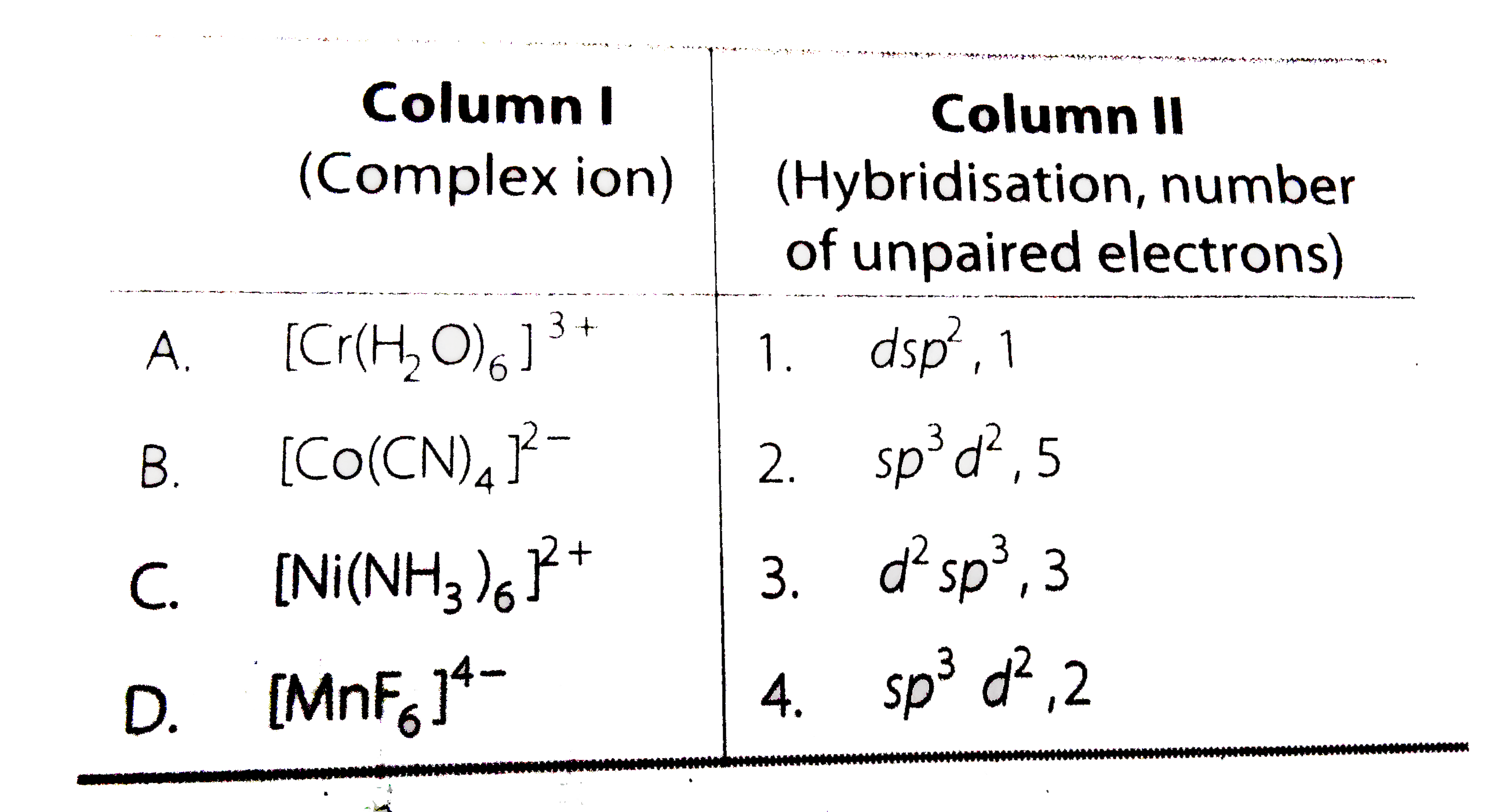Nickel (Z=28) combines with a uninegative monodenatate ligands to form a diamagnetic complex [NiL4]2−. The hybridisation involved and the number of unpaired electrons present in the complex are respectively:
dsp2 , zero
sp3, zero
dsp2, .one
sp3, two
The correct Answer is:A
To solve the problem, we need to determine the hybridization and the number of unpaired electrons in the complex (NiL4)2− where nickel (Ni) has an atomic number of 28 and combines with uninegative monodentate ligands.
Step 1: Determine the oxidation state of Nickel
- Nickel (Ni) has a neutral charge, and when it forms a complex with four uninegative ligands (L), the total charge contributed by the ligands is −4 (since each ligand has a charge of −1).
- The overall charge of the complex is −2.
- Let the oxidation state of Ni be x. The equation can be set up as:
x+4(−1)=−2
Simplifying this gives:
x−4=−2⟹x=+2
Step 2: Determine the electronic configuration of Ni2+
- The ground state electronic configuration of neutral nickel (Ni) is (Ar)3d84s2.
- Upon losing two electrons to form Ni2+, the configuration becomes:
(Ar)3d8
(The 4s electrons are removed first.)
Step 3: Analyze the nature of the ligands
- The ligands are uninegative and monodentate. Since the complex is stated to be diamagnetic, the ligands must be strong field ligands, which means they will cause pairing of electrons in the d orbitals.
Step 4: Fill the d orbitals
- The 3d subshell can hold a maximum of 10 electrons. In Ni2+, we have 8 electrons in the 3d orbitals.
- The filling of the 3d orbitals will look like this:
- 3d orbitals: ↑↓ ↑↓ ↑↓ ↑ ↑
- Since the complex is diamagnetic, all electrons are paired.
Step 5: Determine the hybridization
- The complex (NiL4)2− involves 4 ligands. The hybridization can be determined based on the number of orbitals involved:
- 1 d orbital, 1 s orbital, and 2 p orbitals are used to accommodate the 4 ligands.
- Therefore, the hybridization is dsp2.
Step 6: Count the number of unpaired electrons
- Since all the d electrons are paired, the number of unpaired electrons is 0.
Conclusion
- The hybridization involved in the complex (NiL4)2− is dsp2 and the number of unpaired electrons present is 0.
Final Answer
The hybridization involved and the number of unpaired electrons present in the complex are respectively: dsp2 and 0.
---
- Nickel (Ni) has a neutral charge, and when it forms a complex with four uninegative ligands (L), the total charge contributed by the ligands is −4 (since each ligand has a charge of −1).
- The overall charge of the complex is −2.
- Let the oxidation state of Ni be x. The equation can be set up as:
x+4(−1)=−2
Simplifying this gives:
x−4=−2⟹x=+2
- The ground state electronic configuration of neutral nickel (Ni) is (Ar)3d84s2.
- Upon losing two electrons to form Ni2+, the configuration becomes:
(Ar)3d8
(The 4s electrons are removed first.)
- The ligands are uninegative and monodentate. Since the complex is stated to be diamagnetic, the ligands must be strong field ligands, which means they will cause pairing of electrons in the d orbitals.
- The 3d subshell can hold a maximum of 10 electrons. In Ni2+, we have 8 electrons in the 3d orbitals.
- The filling of the 3d orbitals will look like this:
- 3d orbitals: ↑↓ ↑↓ ↑↓ ↑ ↑
- Since the complex is diamagnetic, all electrons are paired.
- The complex (NiL4)2− involves 4 ligands. The hybridization can be determined based on the number of orbitals involved:
- 1 d orbital, 1 s orbital, and 2 p orbitals are used to accommodate the 4 ligands.
- Therefore, the hybridization is dsp2.
- Since all the d electrons are paired, the number of unpaired electrons is 0.
- The hybridization involved in the complex (NiL4)2− is dsp2 and the number of unpaired electrons present is 0.
The hybridization involved and the number of unpaired electrons present in the complex are respectively: dsp2 and 0.
Similar Questions
Nickel (Z=28) combines with a uninegative monodentate ligand X− to form a paramagnetic complex [NiX4]2−. The number of unpaired electron(s) in the nickel and geometry of this complex ion are, respectively:
View SolutionThe number of unpaired electrons present in complex ion [FeF6]3− is:
View SolutionVelence bond theroy describes the bonding in complexs in terms of coordinate -covalent bond resulting from overlap filled ligand orbitals with vacant metal hybrid orbitals This theory explains magnetic behaviour and geometrical shape of coordination compounds Magnetic moment of a complex compound can be determined experimentally and theoretically by using spin only formula
Magnetic moment √n(n+2)BM (where n = No. unpaired electrons) .
Ni2+ cation combines with a uninegative monodentate ligand XΘ to form paramagnetic complex [NiCI4]2− The number of unpaired electrons(s) in central metal cation and geometry of this complex respectively are
(a) One,tetrahedral
(b) Two,tetrahedral
(c ) One,square planar
(d) Two, square planar .
View SolutionIn hexacyanidomanganate(II) ion the Mn atom assumes d2sp3- hybrid sates. Then the number of unpaired electrons in the complex is .
View SolutionHexafluorocobaltate (III) ion is an outer orbital complex. The
number of unpaired electrons present in it is
View SolutionMatch the complex ions given in column I with the hybridisation and number of unpaired electrons given in column II and assign the correct code

View SolutionConsider the following complex [Co(NH3)5CO3]ClO4
The coordination number, oxidation number number of d-electrons and number of unpaired d-electrons on the metal are respectively
View SolutionConsider the following complex [Co(NH3)5CO3]ClO4
The coordination number, oxidation number number of d-electrons and number of unpaired d-electrons on the metal are respectively
View SolutionConsider the follwing complex:
[Co(NH3)5CO3]Br
The coordiantion number, oxidation number, number of d-electrons and number of unpaired d-electrons of the metal are respectively:
View SolutionBoth [Ni(CO)4] and [Ni(CN)4]2− are diamagnetic The hybridisations of nickel in these complexes , respectively are :
View Solution
